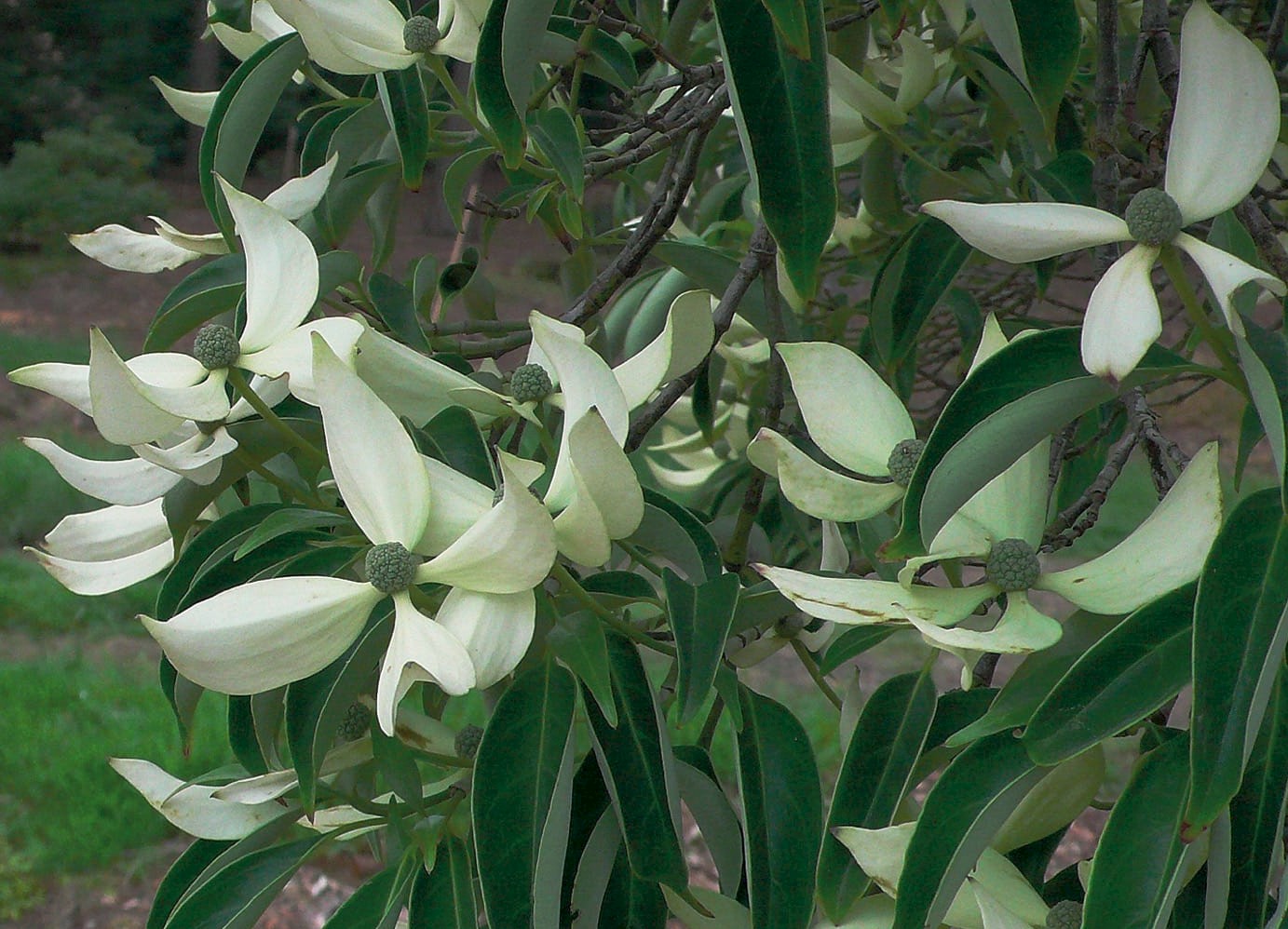Cornus elliptica
Credits
Article from New Trees by John Grimshaw & Ross Bayton
Recommended citation
'Cornus elliptica' from the website Trees and Shrubs Online (treesandshrubsonline.
Genus
Synonyms
- C. angustata (Chun) T.R. Dudley
- C. capitata subsp. angustata (Chun) Q.Y. Xiang
- C. capitata var. mollis Rehder
- C. kousa subsp. angustata Chun
Other taxa in genus
- Cornus alba
- Cornus alternifolia
- Cornus amomum
- Cornus asperifolia
- Cornus australis
- Cornus baileyi
- Cornus canadensis
- Cornus capitata
- Cornus chinensis
- Cornus controversa
- Cornus × dunbarii
- Cornus florida
- Cornus glabrata
- Cornus hemsleyi
- Cornus hessei
- Cornus hongkongensis
- Cornus × horseyi
- Cornus kousa
- Cornus macrophylla
- Cornus mas
- Cornus monbeigii
- Cornus nuttallii
- Cornus occidentalis
- Cornus paucinervis
- Cornus racemosa
- Cornus rugosa
- Cornus sanguinea
- Cornus schindleri
- Cornus sessilis
- Cornus stolonifera
- Cornus wilsoniana
Shrub or tree to 12 m. Bark grey or greyish brown. Branchlets grey-green with white trichomes. Leaf buds with triangular-lanceolate scales, subtending floral buds; floral buds exposed and subtended by four small, green bracts. Leaves evergreen, 7–9(–12) × 2–4 cm, leathery, shape variable, from oblong to elliptic to lanceolate, both surfaces grey-green and densely pubescent with white, appressed trichomes, sometimes tufts of soft trichomes in lower vein axils, three to four secondary veins on each side of the midvein, margins entire and somewhat revolute, apex acuminate to caudate; petiole 0.5–1.2 cm long, covered with white trichomes. Inflorescence terminal, globose cymes, 0.8–1.2 cm diameter, composed of 55–80(–95) flowers; floral bracts yellowish green, turning white, ovate to obovate, 2.5–5 × 0.9–2.2 cm. Flowers hermaphrodite, rather inconspicuous, with ovate petals to 0.3 cm long. Fruits syncarpous, resultant berry 1.5–2.5 cm diameter, globose, held on slender peduncle, red at maturity, densely covered in white trichomes and with multiple stones. Flowering June to July, fruiting October to November (China). Gardener 1979, Xiang & Boufford 2005. Distribution CHINA: Fujian, Guangdong, Guangxi, Guizhou, Hubei, Hunan, Jiangxi, Sichuan. Habitat Forested slopes and streamsides between 300 and 2200 m asl. USDA Hardiness Zone 7–8. Conservation status Not evaluated. Illustration NT266. Taxonomic note See Cornus capitata for further comparisons and comment.
The sample list of synonyms given above (for complete synonymy, see Flora of China) demonstrates that Cornus elliptica has had a chequered taxonomic past, revolving principally around various combinations of the epithet angustata. Its status as a distinct species has only recently been confirmed. DNA evidence suggests that it is not as closely related to typical C. capitata as previously thought, and it is recognised as a separate species in Flora of China (Xiang & Boufford 2005). Morphologically the two can be distinguished by the shorter, thicker peduncles in C. capitata, with flattened globose infructescences, and the longer, more slender peduncles in C. elliptica, which has globose infructescences. This is the situation in typical specimens, but intermediates do occur (Xiang & Boufford 2005).
In its typical form C. elliptica is quite distinct, having more abundant white hairs on the undersides of its leaves than C. capitata, which make them feel rougher. The upper leaf surfaces are also a glossier green than in C. capitata, in which they are a dullish grey-green. At the US National Arboretum in June 2006 some larger specimens (5–6 m) were flowering; as reported by others (for example, Hogan 2008), the ‘flowers’ are rather small, though on some trees they can be abundant. The lime-green of the unexpanded bracts is delightful – but it is as an appealing evergreen with benefits that this species is most likely to be cultivated. Hogan notes that it is considerably hardier than C. capitata, tolerating –12 ºC with minimal damage. In his experience it requires ample moisture and dappled shade to thrive. It does particularly well in such conditions in the Gully at RHS Rosemoor, Devon (C. Bailes, pers. comm. 2007). The first recorded collection was made by Dr Ted Dudley on the 1980 Sino-American Botanical Expedition (when it became known as Cornus angustata), and from this it came to be established in the United States, although later introductions have supplemented the population. It has been grown at the Hillier Gardens since the 1970s, however, when material of unknown antecedents was received from ‘a garden in Ireland’, as C. capitata C. florida (A. Coombes, pers. comm. 2007). Selections have been made for good evergreen qualities, including ‘First Choice’ from the JC Raulston Arboretum, while ‘Elsbry’ (Empress of China) was chosen by John Elsley for its abundant blooms (Lasseigne 2001, Cappiello & Shadow 2005).

